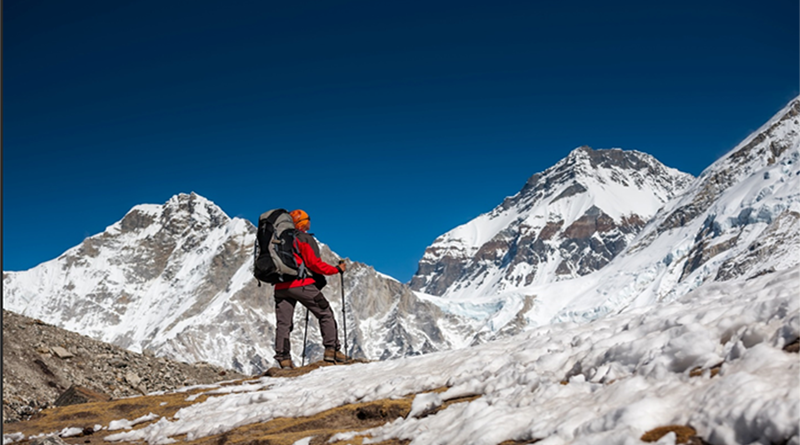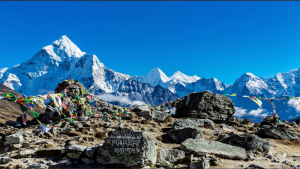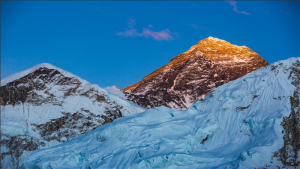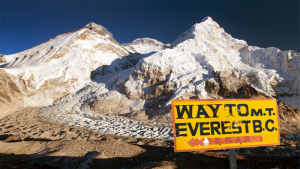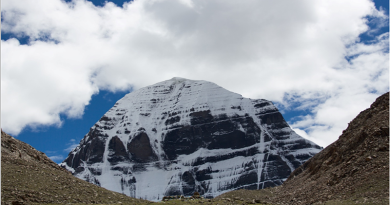Everest Base Camp Trek in April, What to expect and How to prepare?
Everest Base Camp in April
The ineffable existence of nature, Everest Base Camp is a once upon a lifetime journey that resembles the rawness, purity, and organicity of the true form of nature. The trek takes you to the base of the highest peak in the world handling a lot of challenging routes, and the unimaginable reality of nature.
The Everest Base Camp trek journey mostly begins with months of April of blooming flowers regenerating leaves, chirping birds, and a pleasant atmosphere of transforming nature into vibrant greenery. The month of April welcomes ‘Basanta Ritu’ in Nepali meaning the season of regenerating lives. This is the perfect time to witness nature transforming itself. The Months of March to May are considered as a perfect occasion for connecting to the Nepalese Himalayas and nature.
Why April?
Nepal offers five distinct seasons over the years experiencing heavy rainfall in monsoon, dry humid hot in summer, and too cold in winter for trekking. Analyzing the practical weather conditions, Spring is set to be the best season to witness the grand creation of nature providing the best atmosphere for hikers. The month of April falls in the Spring season which delivers adequate weather conditions for acclimatizing one above 3000 m and a clear sky allowing safe travel.
In Nepal, Spring season is known as ‘Basanta Ritu’ meaning the months of transformation of nature into its new life. This is the perfect time to encounter the blooming red rhododendrons over the greenery hills, the chirping sound of birds shifting their homes, and a time to cherish the vibrant sunshine radiating positivity beneath the heavenly mountains.
April is the month of historical and cultural events and practices that reflect the religious aspects of Himalayan life. Despite being the most favorable time of the year, comparatively little traffic is seen which makes it more adventurous during these months.
This is the time of clear sky, adequate temperature, and proper availability of lodges and hotels for accommodation. The true picture of Nepalese Himalayan life can be perfectly documented during this month.
Excitements and Challenges awaiting for you
Everest Base Camp trek introduces you to the death-threatening landscapes where brave Himalayan Sherpa people, Himalayan wildlife, and cultural and historical heritages are well placed. Reaching the base of the world’s highest peak is not as easy as you think. Lots of hurdles, cramps, altitude sickness, and traveling difficulties arise due to acclimatization problems.
The journey to the Everest Base Camp is itself an achievement for any nature enthusiast. Walking above the terrains, rivers, and forests and exploring the village Gumbas itself gives an immersing pleasure and self-satisfaction. The trek to Everest radiates a vibrant energy of continuing the process no matter what life gives you.
You may face severe challenges during the trek including
- Altitude difficulties Disheartening and Challenging Routes
- Battling against Freezing minus-degree temperature
- Language barrier
- Himalayan cuisine
Weather During April in EBC trek
April falls under Spring season in Nepal which is considered the best season with clear blue skies and adequate weather conditions. This season is best for hikers seeking the panoramic views of the Everest region. Filled with redly decorated rhododendrons and beautiful butterflies flying all over the bunch of flowers reflects the moment of joy
Spring Season (April-May)
Daytime Temperature 15 degrees C
Nighttime Temperature -1 degree C
Wind speed- 11km/h
Precipitation/month- 7mm
Sunshine hours/day- 9
Best Months considering weather and visibility
The favorable season depends upon the level of trekking offered by the hikers. For a beginner who wants to witness the magic happening in the highest peak in the world, without a doubt, April is considered the most favorable but for the trekkers who accept the challenge and have the guts to battle against the harsh nature, winter might be the best one.
Analyzing the survey done to choose the best season among trekking guides 90% have given thumbs up on Spring as their best favorable season and 80% have chosen April as the best month for the trek. Thus, for normal hikers, April delivers a commendatory experience.
Impact of Monsoon in EBC trek
Monsoon experiences considerable rainfall of 170 mm which may impact your schedule. The months from June to September experience heavy rainfall making the hike pretty dangerous, and the chances of an avalanche certainly increase due to continuous rain. However, the temperature rises to 22 degrees C which is a great sign for hikers during these months.
Physical Fitness required for the Trek
Without any second thought, the EBC trek is the ultimate synonym of difficulties. To cope with the extreme temperature, weather, roads, and countless hurdles, one needs to not only be physically fit but also mentally well prepared. It’s like going to war against life-threatening difficulties
We have designed our trekking plan in such a way that even a moderate-level fit person can hike around the hills and snow without any further difficulties. Taking the proper diet supplements on a proper timing basis and adequate rest can decrease the risk of cramps and injuries during hiking.
Let’s Know the periphery of EBC for fitness
Everest Base Camp breaks the Shackle of every bit of biodiversity in trekking ingredients. From terrains, rivers, and glaciers to snow-capped routes, one needs to encounter challenging tracks performing good athleticism. Major parts of the routes are easy and moderate where some of them require some serious athleticism. The routes from Jorsalle to Namche and Pungi Thanga to Tengboche require good skill and stamina however, it may be an easy task for the gym freak. Acclimatizing the altitude properly along with proper rest can help in recovering the physical and mental stamina back right for the next day. You need to pass the most difficult walk in Kala Patthar sensibly.
Basic fitness is the major requirement of EBC trek. However, if you are a gym freak, you are already ready for the trek. If you are not involved in Physical activities you should train yourself to walk 4 to 7 Kilometers daily at least for 20 days. This is the minimum bandwidth to successfully chase your dream of reaching the camp.
Gear and Equipments required
For sure when you are walking on one of the most difficult pathways under extreme temperature, you definitely will need some serious gear and equipment which are necessary for climbing the snowy surface. However, it depends upon your personal preferences and requirements regarding what exactly you want to pack in your bags. But it is recommended that your gear bag should be as light as possible.
When you are trekking in April, you don’t need large sets of gear and equipment. The favorable temperature and weather condition allows you to hike wearing following basic gears
- Waterproof jacket
- Lightweight Down jacket
- Waterproof trousers
- Lightweight trekking trousers
- Two-three trekking T-shirts.
- Lighter Hiking sneakers and shocks
Camping Gears during April
If you are a desperate Everest lover and want to experience the extreme conditions in the Everest region then for sure, Camping gear is most useful. It may include
- A four-season sleeping bag
- Sleeping bag liner
- Pillow
- Head torch
Tips:
It is recommended to include the first aid box, your regular medicine along with throat lozenges, and flue medicine to get rid of the ‘Khumbu Cough’ including some breath mints as well. Make sure that your bag is waterproof and strong enough to carry each bit of your necessities. Garlic is considered good for quick acclimatization ensuring your body fights against biotic.
If you are having scarcity in budgeting then you may have an option to take the gears on rent. The rented gears are quite productive with minimal costs. This is the biggest mantra that every trekker misses. But make sure that the gears are good in condition before accepting it.
Acclimatization
A normal person is never habitual to such a high altitude, low oxygen level, and death-taking temperature. It may be very difficult to survive if you proceed without acclimatizing properly. To be habitual to the condition, one needs to rest and let oneself breathe in a low oxygen region for some period. Taking proper supplements, and nutrients and giving time to the body is essential.
Talking scientifically, during acclimatization, the human body will have enough rest to produce an adequate amount of Red blood cells which transport oxygen to the muscles and organs. As the trek to EBC lies above 2,500 m, acclimatization becomes essential.
According to our schedule, you will be acclimatizing by staying each night in a span of 200-600 m altitude. For a day, you will be acclimatizing by exploring the Namche Bazar and the Dingboche as well. Here is why Acclimatization is important
- Prevents Altitude Sickness
- Increases Psychological Adaptation
One can properly prevent the acclimatization problem during the Everest Base Camp Trek in the following ways
- Staying Hydrated
- Hike to Higher Hills
- Practice Deep Breathing Exercise
- Taking Acclimatization Pills
- Having a Balanced Diet
Symptoms of Altitude Sickness
- Nausea and Vomiting
- Fatigue
3 . Shortness of Breathed
- Insomnia
- Swelling of Hands, feet, or face
- Headache
- Increase in heart rate.
Permission Required
For the trek to Everest Base Camp, one need to take two permission which is Khumbu Rural Municipality Permit and Sagarmatha National Park Entry Permit.
1, Khumbu Rural Municipality Permit
The fee structure for the permit differs from your home country stating the SAARC countries cost NPR 2000 per person for the first four weeks but after the four weeks, the cost increases to 2500. The permit can easily be obtained by submitting a copy of the Passport of your respective country to the Lukla branch or Sagarmatha National Park Counter in Monjo.
-
Sagarmatha National Park Permit
For the Sagarmatha National Park permit, one needs to pay NRS 3000 for visitors from another country than SAARC but for SAARC visitors it is certainly NRS 1500. This permit can be acquired from the Nepal Tourism Board Office situated in Pradarshani Marg in Kathmandu. The same permit can also be taken from the Sagarmatha National Park counter office in Monjo.
Accommodation Service available during the trek to Everest Base Camp
Regardless of the destination you trek, sound sleep is most important to recover all your pain and stress throughout the journey. In this trek to the Everest Base Camp, you will witness hundreds of hotels, lodges, and homestay services on the trails.
The accommodation services available are mainly Tea houses, Homestays, Hotels and Lodges. As the altitude is high, you may lack luxurious service due to lack of transportation. You will get twin rooms having two single bed with a pillow, sheets, and bed cover. However, we recommend to use your sleeping bag for hygiene purpose.
The lodging and fooding facilities depend but tea houses provide well- village typo peaceful local luxury. These Homestays also serve the typical traditional Himalayan cuisine resembling the artistic beauty in Nepalese meals.
Any Tips wanted?
The Price for the accommodation service ranges according to the altitude, time, and the quality of services. It is very difficult to get a good lodging service during April as this is the most preferred months of trekkers around the world.
We recommend you to book your room as early as possible or you may contact us we can help you to get good rooms at affordable price. During the months of Autumn and Spring, room prices are high but during Winter it comes to moderate. Generally, $3-$4 per night is the ideal deal to go with. Some of the tea houses don’t charge any fees if you agree to have a meal in their tea house.
Views from Kala Patthar
Fooding Service in April
EBC trek is widespread over kilometers comprising distinct Himalayan culture, tradition, and people. Different cultural group habitant in different altitude has their own identity which are reflected in their food menu. From Thakali Khana to the spectacular taste above 4,000 meters, you will encounter exciting fooding hospitality from the Nepalese Himalayan Circuit.
During April various cultural events takes place that may allow you to taste the Nepalese Himalayan kitchen hospitality with local cuisine.
When you travel at high altitudes, proper food containing nutrition should be preferred. Oatmeal, Bread, Chapatti, Pancakes, Omelets. Paratha are served as breakfast. You may also order typical Nepalese kitchen snacks and sweets in some tea houses.
There is a special proverb “Dal Bhat Powers 24 Hours”. Popular Thakali khana and Newari khana are preferred by most trekkers for Lunch and Dinner.
Local Cuisine
Tea houses in EBC trek serve Nepalese traditional cuisine as well as the international food of your country as well. But we recommend you try Nepalese cuisine which is not found elsewhere in the world. Tsampa, Riki Kur (potato pancakes), and Tibetan Bread for breakfast are fulfilling. The Nepalese tastes like Veg Shakpa (Sherpa Stew), Veg Thukpa (noodle soup), Tmomo, and Rildhuk (soup with potato lumps) are great for lunch and dinner. If you consider meat in your diet then you may consider Sekuwa, and other meat-related cuisine that delivers the distinct taste you never tried.
Best diets for better hydration
For proper Hydration, dishes like Soup and thukpa are most recommended. You should carry a thermos bottle filled with warm water throughout the journey. Drinking water and water-enriching ingredients allow your body to perform better in circulation. We recommend you carry 2-3 bottles of water and some water purification tablets throughout the journey. The tablets can be found at cheap rates that clear all the germs within 90 seconds.
Highlighted Attraction of EBC on April
Everest feels more than heaven during this month allowing the crystal clear views and vibrant atmosphere through the Everest region. Some of the major attraction that makes the Everest base camp trek more special in April are
- Cultural events of Sherpa for welcoming ‘Basanta Ritu’.
- Forests, terrains, and villages decorated with red Rhododendron flowers blooming red all over the mountains.
- Clear and predictable weather condition
- Access to large food option
- Proper medication facilities in April
- Access to Helicopter service in April.
Health and Safety
During April, you won’t face the problems regarding temperature but the problems of Altitude Sickness and excess leg pain arise as you need to hike through the hills and terrains while experiencing a frequently changing atmosphere.
Surviving in the Everest region is very tough as medical problems may arise at any point at such a high altitude. For proper medication, the Himalayan Rescue Association of Nepal a nonprofit organization provides OPD health services. Besides this, there are few health clinics providing health services along with online health services as well for the trekkers in this region.
Communication
High-speed 3G Internet service is already available even in base camp. For that, you need to buy the SIM of NCELL or NTC and recharge as per the plan however, we recommend you to carry a powerful power bank for the mobile and electronics. Charging is very expensive in the Everest region above 4000 m. Except for tea houses and Lodges mobile charging and Internet price is $2 to $4 per hour.
WiFi facilities are available in different hotels, lodges, and homestays but are slightly high in price. However, you may get a free internet connection in your lodge and homestays.
Everest Base Camp
Budgeting expenses
The budgeting of the EBC trek depends upon the time of visit and the luxury you afford. It may range from $1299 for budget trek and $4000 for Everest base camp luxury trek which also depends upon the route, time, and services offered. IF
The budgeting can be breakdown into
-
Expenses in Kathmandu
This includes accommodation, and a visit to historical, cultural, and religious sites along with your expenses which will certainly be more than US$60 to US$120.
-
Transportation expenses
The flight from Kathmandu to Lukla costs around $360 to $380. You may book your ticket as early as possible to save your flight cost. You may also book a bus ticket or a jeep which will certainly save a lot of your budget taking you through the rural highway.
-
Visa Cost
Except for Indian nationals, trekkers from all countries need a visa to enter Nepal. The visa cost for Nepal is at the given Rate
$30 – 15-day multiple entry visa
$50 – 30-days multiple entry visa
$125 – 90-days multiple entry visa
We strongly recommend you take a visa of 30 days for the EBC trek.
-
Permit Cost
You need two permits for the EBC trek
Sagarmatha National Park Permit: NRs 3000
Khumbu Municipality Permit: NRs 2500
-
Accommodation Cost
The accommodation costs vary according to the altitude. The accommodation cost at the highest altitude is $10 which is at Gorakhpur. One can take an average of $8 daily for 15 days while budgeting.
-
Costs of Food
As you proceed to the altitude, you will notice a massive increase in fooding costs. This is due to the very dangerous geographical structure of routes. The fooding costs start from $5 in the beginning and $12 at Gorakshep. However, you may take an average of $10 per meal on fooding making the daily expenses $30 to $40.
-
Cost of Guide
According to the latest rules and regulations, one must hire a guide for proper safety due to the number of trekkers missing case during trekking. The average cost for the guide in Nepal is $30-$35 meanwhile the average cost for the portal is $20-$25.
-
Travel insurance and VAT
Insurance is always a life savior when you trek in such a high altitude. The travel insurance for trekking allowing up to 6000 meters will cost $150 for a 30-day time. The cost may fluctuate according to your age and country of residence.
Nepal government charges 13% VAT for every trekker on any of the trekking routes in Nepal.
-
Equipment and Gears
The general price for trekking gear sets is $200 to $500. If you intend to save your budget, you may rent the traveling and trekking equipment from rental services available in Kathmandu.
Training Tips
- Preparing for the strength and stability
- Flexibility fitness programs (Individual body part stretching, exercises for hamstrings, glutes, hips, calves, lower back, and quadriceps)
- Climbing Conditioning (Harder workouts)
- Aerobic classes and cardiovascular conditioning (Examples: biking, rowing, and swimming)
- Hiking-specific training (walking uphill and downhill with a backpack of (10 to 15lbs)
One should practice Strength based exercises such as Shoulder Presses, Push-ups, Side Lunges, Sit-ups and Toe-ups, Squats, Step aerobics along with some Aerbic and Cardiovascular trainings such as Box jumps, Zumba, Spinning, Jumping jacks, etc.
Here are the routines made by the Sherpas and Experienced Trekkers for the EBC preparation.
| Exercises | Sunday | Monday | Tuesday | Wednesday | Thursday | Friday | Saturday |
| Strength related Exercises | 30 minutes | 30 minutes | 30 minutes | 30 minutes | 30 minutes | 30 minutes | 30 minutes |
| Flexibility related Exercises | 20 minutes | 20 minutes | 20 minutes | 20 minutes | 20 minutes | ||
| Aerobic and Cardio Exercises | 30 minutes | 30 minutes | 30 minutes | ||||
| Hiking Trainings | 3 to 4 hours |
To battle against variable weather conditions, exercise like Rock climbing, swimming, biking, and running on slippery trains becomes essential. Getting used to the sunlight should also be a major part of preparation for the trek in April.
Mental preparations
If this is the first time you are trekking then you should be clear about the decision first. Once we start our hike, there is no look back except if any medical issues arise during the trek. The best thing about the EBC trek is that you don’t need any motivation. The nature and the atmosphere here itself create an aura of doing it till the last breath.
You should be mentally ready to experience any upcoming challenges that arise during the trek. You may have some meditation classes right before your arrival. The alluring landscapes will never make you mentally disturbed.
Conclusion
EBC trek is a once-in-a-lifetime journey delivering every sort of trekking ingredient from rivers, terrains, hills, and mountains. This journey is composed of vibrant positivity revealing the secret behind the magical creation of nature. You will face troubles, adjustments, and complications but all these experiences will be responsible for your upcoming life and career development i.e. at the end of the day experience is the only thing that matters. We wish a very good luck on your journey to encounter the indescribable art of god.

